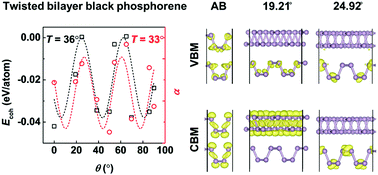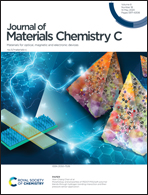Tuning the electronic properties of bilayer black phosphorene with the twist angle†
Abstract
Two-dimensional (2D) twisted bilayer materials have displayed rich new physics, depending on the interlayer interaction mediated by the twist angle. Here, we performed systematic first-principles calculations to investigate the structural and electronic properties of twisted bilayer black phosphorene (TBP) with different twist angles. We found that the cohesive energy of TBP relies on the rotation angles with a periodicity of about 36°, which can be understood by using an interlayer orbital overlap model. An electronic polarization along the vertical direction exists in the TBP systems with weak interlayer coupling, but it disappears in those with strong coupling. Interestingly, the electronic and transport anisotropy as found in the monolayer can be continually tuned by changing the rotation angle of TBP from 0° (AA, AB, and Aδ stacking) to 90°. Finally, TBPs with different interlayer coupling strengths show distinct behaviors in band gap change and charge density distribution under an external electric field. These results deepen the understanding of the interlayer interaction of twisted 2D layered BP with van der Waals interaction, and provide a novel way to precisely tailor the electronic band structures and anisotropic behaviors of carrier transport in layered materials.



 Please wait while we load your content...
Please wait while we load your content...